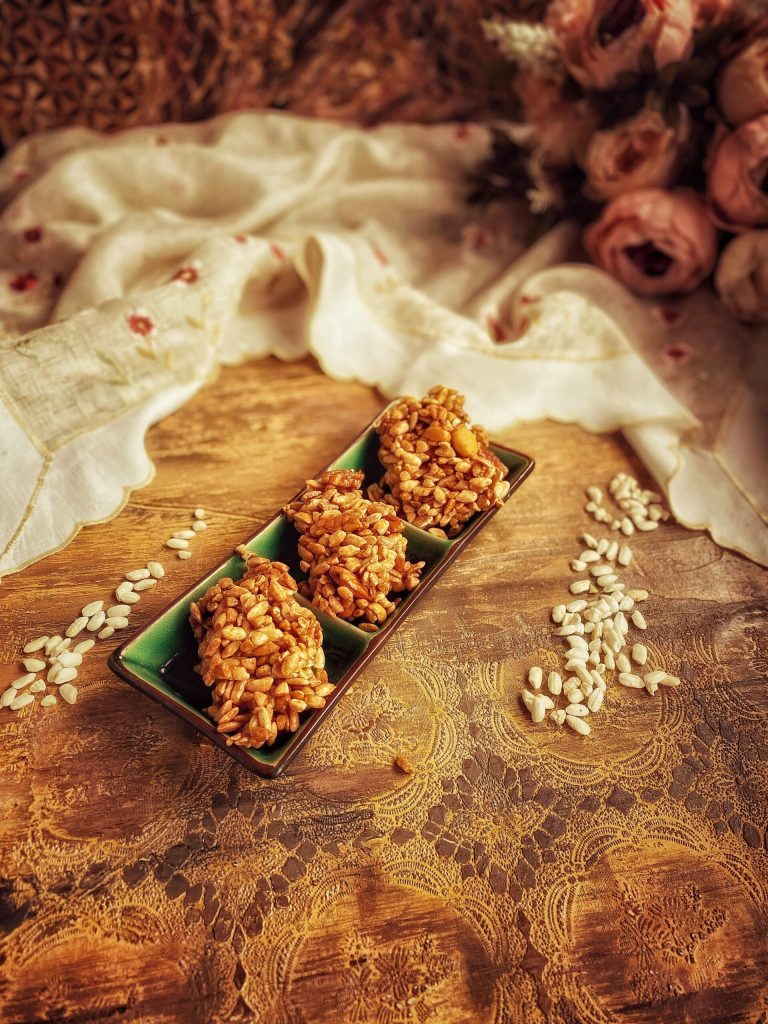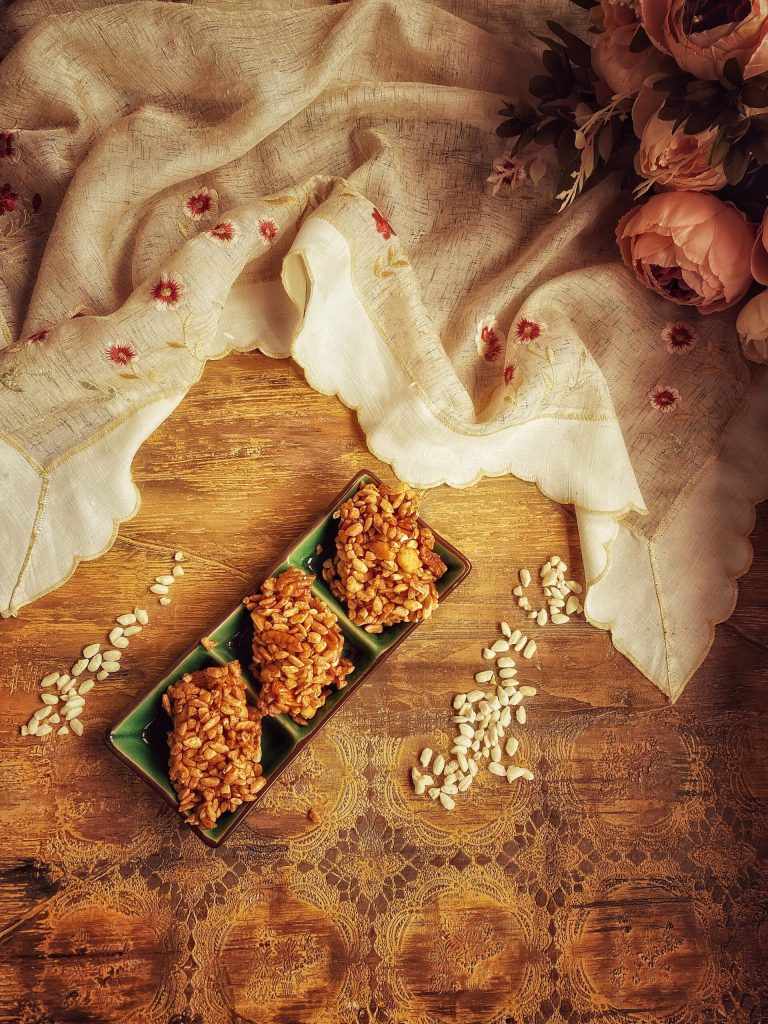Yeot-gangjeong 엿강정 is a type of HANGWA* (traditional Korean sweet) similar to a bar, made of roasted seeds, nuts, peanuts, sesame, and/or puffed rice grains mixed with “Ssal-jocheong” (쌀조청), which is white rice (ssal) syrup.
▶Families prepare and eat yeot-gangjeong during Korean holidays such as Chuseok (harvest festival), Seollal (Korean New Year), and Jesa (ancestral rites).
Or it is prepared and sold as a winter snack and usually consumed during festivals.
*Common ingredients of hangwa include: flour, fruit and roots, sweet ingredients like honey and YEOT, and spices like cinnamon and ginger.
❗Let’s clarify some terms…
🔹YEOT = a type of hangwa that can be made liquid or solid, with: rice, glutinous rice, glutinous sorghum, corn, sweet potatoes, or mixed grains.
▶▶YEOT boiled for a shorter time is called “jocheong”, or liquid yeot. This sticky jocheong is similar to syrup, specifically rice syrup.
▶▶YEOT boiled for a longer time will solidify and, once cold, is called “gaeng yeot”.
Other Korean hangwa you can find on the blog:

- Difficulty: Medium
- Cost: Inexpensive
- Rest time: 2 Hours
- Preparation time: 10 Minutes
- Portions: 6 people
- Cooking methods: Boiling
- Cuisine: Korean
- Seasonality: All seasons
Ingredients
- 8.8 oz rice syrup
- 3.5 oz sugar
- 3.5 oz puffed rice
- 5.6 oz mixed nuts, almonds, peanuts
Tools
- 1 Parchment paper
Steps
Bring the rice syrup to a boil with 6 tablespoons of water and sugar, until it reaches 230°F (110°C) or until bubbles form.
Turn off.
Pour in the puffed rice and the mix of nuts, almonds, and peanuts. Work the mixture quickly with a spatula.
Spread in a rectangular pan covered with parchment paper and shape.
Cool (if necessary, even in the fridge) then cut into bars.

FAQ (Questions and Answers)
What are the variations of Yeot?
The variations of yeot are named after their secondary ingredients, such as:
Ssallyeot ( 쌀엿 ) – made with rice
Hobakyeot ( 호박엿 ) – made with pumpkin, a local specialty of Ulleungdo
Hwanggollyeot ( 황골엿 ) – made with a mix of rice, corn, and malt
Kkaeyeot ( 깨엿 ) – coated with kkae ( 깨 , sesame)
Dangnyeot ( 닭엿 ) – a local specialty of Jeju Island, made with glutinous millet and chicken
Kkwongnyeot ( 꿩엿 ) – a local specialty of Jeju Island, made with glutinous millet and pheasant meat
Dwaejigogiyeot ( 돼지고기엿 ) – a local specialty of Jeju Island, made with glutinous millet and pork
Haneuraegiyeot ( 하늘애기엿 ) – a local specialty of Jeju Island, made with glutinous millet and haneulaegi herb
Boriyeot ( 보리엿 ) – a local specialty of Jeju Island, made with barley
Maneullyeot ( 마늘엿 ) – a local specialty of Jeju Island, made with glutinous millet and garlic
Gochgamyeot ( 곶감엿 ) – a local specialty of Sangju, made with dried persimmons
Yakyeot ( 약엿 ) – made with sesame, nuts, ginger, jujube. Traditionally used as a tonic for the sick.
Tongoksusuyeot ( 통옥수수엿 ) – made with cornWhat are the categories of Hangwa?
Hangwa can be classified into eight main categories:
candy, dasik (tea food), gwapyeon (fruit jelly), jeonggwa (dried fruit), suksil-gwa, yeot-gangjeong, yugwa, yumil-gwa.
Candy – Traditional Korean candies can be eaten as they are or used as sweetening ingredients in other types of hangwa.
Dang ( 당 ;糖; “candy”) or Dangryu ( 당류 ;糖類; “candy category”) refers to hard sweet treats. It can be made from crystallized sugar or saccharified starch.
Dasik, literally “tea food”, is a miniature sweet normally paired with tea. It is made by pressing honey powder into a decorative mold.
Typical ingredients include: rice flour, pine pollen, black sesame, chestnuts, and soy.
Gwapyeon is a gelatinous summer sweet made with a variety of fruits, like berries, cherries, and apricots. It is made by mixing fruit juice with starch and agar agar for a gelatinous texture.
Jeonggwa is a crispy chewy dessert made from candied fruit, roots, or seeds.
Common ingredients include: yuja, quince, apricot, lotus root, radish, carrot, ginseng, balloon flower root, ginger, burdock root, bamboo shoots, and winter melon.
Suksil-gwa, literally “cooked fruit”, consists of fruit, roots, or seeds cooked and sweetened with honey.
Common ingredients include: chestnuts, jujubes, and ginger.
Yeot-gangjeong, the recipe above.
Yugwa is a fried sweet made with glutinous rice flour dough. It can be classified as gangjeong, sanja, and hangwa depending on its shape and size.
Yumil-gwa refers to a fried sweet made from wheat flour dough.
It can be made with various ingredients like: honey, cooking oil, cinnamon powder, nuts, and cheongju (rice wine).
It can be classified as mandu-gwa (dumplings), maejap-gwa (ribbons), or yakgwa (flower) depending on the cooking methods.
Other varieties of hangwa include:
Gotgam-mari is a roll made with dried persimmons and nuts.
It can be prepared by rolling a toasted and peeled walnut with a dried persimmon, deseeded and flattened, then slicing each roll as if slicing a kimbap.
Yaksik, also known as yakbap, is a sweet rice dessert made of steamed glutinous rice mixed with honey, soy sauce, jujubes, chestnuts, pine nuts, and sesame oil.

